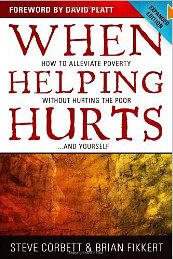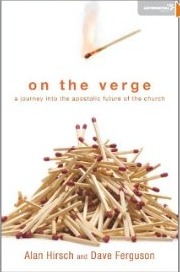by Steve Corbett and Brian Fikkert
When Helping Hurts addresses a Christian response to poverty and community development. The authors confirmed some things that I have known intuitively and introduced me to some great new ideas and strategies. One of the most important concepts in the book is the definition of poverty as the
“result of relationships that do not work, that are not just, that are not for life, that are not harmonious or enjoyable. Poverty is the absence of shalom in all its meanings.” (p.59)
In the materialistic West, we tend to think of poverty as the lack of finances and things; so, we assume that throwing money and resources at the problem will fix it. Experience tells us that this is not the case. Such tactics often entrench people even further in poverty by teaching them to become dependent on the generosity of others instead of working.
If we accept that poverty is the result of broken relationships with God, ourselves, other people, and the creation, then alleviating poverty requires us to commit to the often messy and slow work of restoring those relationships.
A Christian response to poverty initially will focus on restoring the poor to a proper relationship with God through the Gospel. Knowing him as Savior, Lord, Provider, Sustainer, and Keeper – the One who loves us past comprehension – will produce faith that will enable boldness and perseverance in the quest to escape the chains of poverty. Secondly, people need to have their sense of personal worth and dignity restored. Many poor people have accepted the world’s valuation of them as being worthless and incapable. The gospel restores dignity to human beings that inspires confidence and courage to break free. The third leg of the table is the restoration of wholesome life-giving relationships with other people who are willing to mentor, equip, and support them in their journey out of poverty. Lastly, the gospel restores us to a proper relationship with creation by teaching us to be good stewards who appreciate the value of working for God’s glory. With the help of God’s sustaining grace, what was a curse regarding circumstances, family, past mistakes, lack of education, etc. can be turned into a blessing.
While many well-to-do people think of poverty as the absence of things, the poor themselves define it in terms of shame, powerlessness, hopelessness, and having no voice.Much harm has been done unintentionally by well-meaning people who have used a materialistic definition of poverty to come up with a materialistic solution.
The non-poor often have “God complexes” and see themselves as the answer to needs of the poor. This coupled with the feelings of shame and inferiority of the poor who are being “helped” leads to a result that often hurts those who are “helping” and those being “helped.” The authors encourage a much different approach, one that involves a true partnership with and honoring of the poor.
The authors define poverty alleviation as
“the ministry of reconciliation: moving people closer to glorifying God by living in right relationship with God, with self, with others, and with the rest of creation.” (p.74)
Westerners usually do not choose this strategy because it is a relatively slow process for which success is hard to measure. Instead we have most often opted for a “neater and cleaner” way that actually causes harm. For example, a typical way to alleviate hunger is to open a food pantry, stock it with food, set policies, get volunteers, open the doors, ask people to line up to see if they qualify, and give the ones who do a box of food once a month. This method is easy to organize and measure – 5000 served! People can get involved in a nice, safe, and scheduled way – show up on Tuesdays from ten until Noon, and no personal connection with poor people is required. Unfortunately, few seem to realize how shaming this method can be to the ones being “served.” It does not help people to learn to provide for themselves. It is just a handout.
The authors encourage a different model. What if a Christian food ministry were to discover that a neighborhood has a chronic food need? That ministry could then talk to some of the neighbors, listen to their stories, and determine what the poor think about their situation. Those within the neighborhood who could serve as connectors to the larger community could be identified and gathered for further discussions that could lead to the adoption of a plan to come up with a way to provide food for the community by the community. Further discussions might lead to the formation of a community co-op. Those who are interested could buy in for, say, $5 a week. The community leaders would then take that money, perhaps, combine it with money from other sources, and purchase food from a food bank and distribute it to their members. This solution involves community participation and leadership at all levels. Not only is low cost food provided, but a sense of worth and dignity is heightened – all to the glory of God. The authors define such material poverty alleviation as
“working together to reconcile the four foundational relationships so that people can fulfill their callings of glorifying God by working and supporting themselves and their families with the fruit of that work.” (p.74)
One of the reasons that poverty alleviation ministries so often end up hurting the people they serve is because they are one dimensional. Poverty alleviation has three stages: relief, rehabilitation, and development.
“One of the biggest mistakes that North American churches make – by far – is in applying relief in situations in which rehabilitation or development is the appropriate intervention.” (p.101)
Handing out boxes of food is a short term crisis averting solution, but, if it is done over a long period, it will likely foster dependence. Crisis relief should be seldom, immediate, and temporary. Rehabilitation involves working within the framework of the existing community to restore a person, with their participation, to where they were before the crisis. Development, also with their participation, takes them beyond where they were prior to the crisis. The authors spend chapters outlining how this can and should be done. The authors also warn against using the rich using their “power” to circumvent the time consuming work of relationship building and community participation. If we want to see long term results we cannot take short cuts. Partnership, not paternalism, is required.
If you are interested in being part of the solution for helping the chronically impoverished, this book can help you immensely. If you are already involved, it may help you to reevaluate what you are doing in order to be even more effective. It is definitely worth the time to read it.




